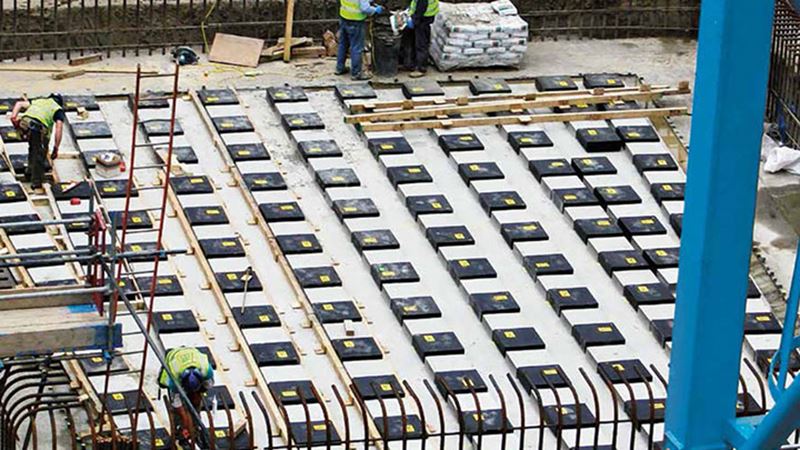The bear necessities of city life

United Nations research projects that by 2050 almost 70 percent of the world’s population will be living in cities. Imagine more than six billion people being exposed to the constant roar of traffic, ceaseless construction noise, sirens, honking horns or the shaking of subway trains.
In fact, trains, subways and cars are the primary causes of noise and vibration. Not only does the human body not respond well to these, but buildings are also affected. There is a growing need for noise and vibration isolation strategies in buildings, especially with the increasing number of prestigious commercial and residential developments springing up in cities worldwide.
Noise and vibration are a nuisance, but they’re also dangerous. The World Health Organization (WHO) describes noise pollution as an underestimated threat that can cause hearing loss, cardiovascular problems, cognitive impairment, stress and depression.
The WHO guidelines for community noise recommend less than 30 A-weighted decibels (dB(A)) in bedrooms for good-quality sleep and less than 35 dB(A) in classrooms to allow good teaching and learning conditions — sound levels best compared to a quiet library or low-voice conversation. A European Union study though found that about 40 percent of the people in EU member countries are exposed to road traffic noise at levels exceeding 55 dB(A); 20 percent are exposed to levels exceeding 65 dB(A) during the day, and more than 30 percent are exposed to levels above 55 dB(A) at night.
The most effective way to control noise and vibration is always at its source. In line with the United Nations’ Sustainable Development Goals — number 11(Sustainable cities and communities), Trelleborg provides technologies for this, for instance, anti-vibration systems on trains, vehicles and machinery. However, further steps need to be taken to control and isolate noise and vibration in the basements of buildings. When installed within the base and body of a building, U Trelleborg’s innovative isolation bearings can dramatically reduce the effects of noise that is radiated onward by the building structure as a result of vibration near the structure.
After an initial assessment by an acoustic technician, the bearing manufacturer ensures that the natural frequency at which the building vibrates on its bearings is at just the right level. This has to be considerably less than what is called the forcing frequency, making the ratio between the two as great as possible (the forcing frequency refers to vibrations that radiate through the ground and into a building’s structure, effectively turning it into a speaker that amplifies sound).
Ideally, the ratio between the natural and forcing frequencies should be three. This gives a transmissibility of 0.1, meaning that 90 percent of the vibrations are detuned. So, for the forcing frequency of 30 hertz coming through the ground, a natural frequency of 10 hertz is the aim.
However, the industry is facing some challenges, as Simon Wolfert, Design Engineer within Trelleborg Industrial Solutions, explains. “Specification guidance for these products is lacking,” he says. “For example, the rate of deflection isn’t always considered in bearing designs. This can be significantly affected by the varying weight distribution of a building and impact on the performance of the bearing.”
The behavior of buildings is also increasingly a factor, given that intense urbanization means they are being built so close to traffic and railways, exposing the building’s structure to increasing noise, vibration and structural stress.
“Therefore, building designs have to incorporate strategies that meet the change in demands from the environment,” Wolfert says. “Isolation bearings are one example of this.”
But when it comes to strategies, it’s a bit of a moving target, due to the lack of guidance.
“Our environment will continue to evolve and develop,” says Wolfert. “Couple that with more stringent regulations in the construction industry and building designs must become even more sophisticated. The nature of our infrastructure is that it is built to last, so we cannot allow substandard products and techniques to take hold.”
Ground vibrations won’t disappear, but given the cost and effort associated with retrofitting units, Wolfert adds, “It’s vital that the industry gets this right the first time. The specification of bearings shouldn’t be feared, as the scientific principles are simple enough. A reinstated, valuable guidance that details this will help drive best practice by manufacturers and provide reassurance to architects, contractors and building owners.”
For more information, please go to:
Bearings
This is an article has been reproduced from Trelleborg's T-Time magazine. To download the latest edition, go to: www.trelleborg.com/t-time
Press Service: This article is available in eight languages. Media are welcome to use this article in their own publications. To download the article and pictures in any language go to https://bamboo-contentpartner.com/. If you reproduce information from this release, please give contact details as: www.trelleborg.com.